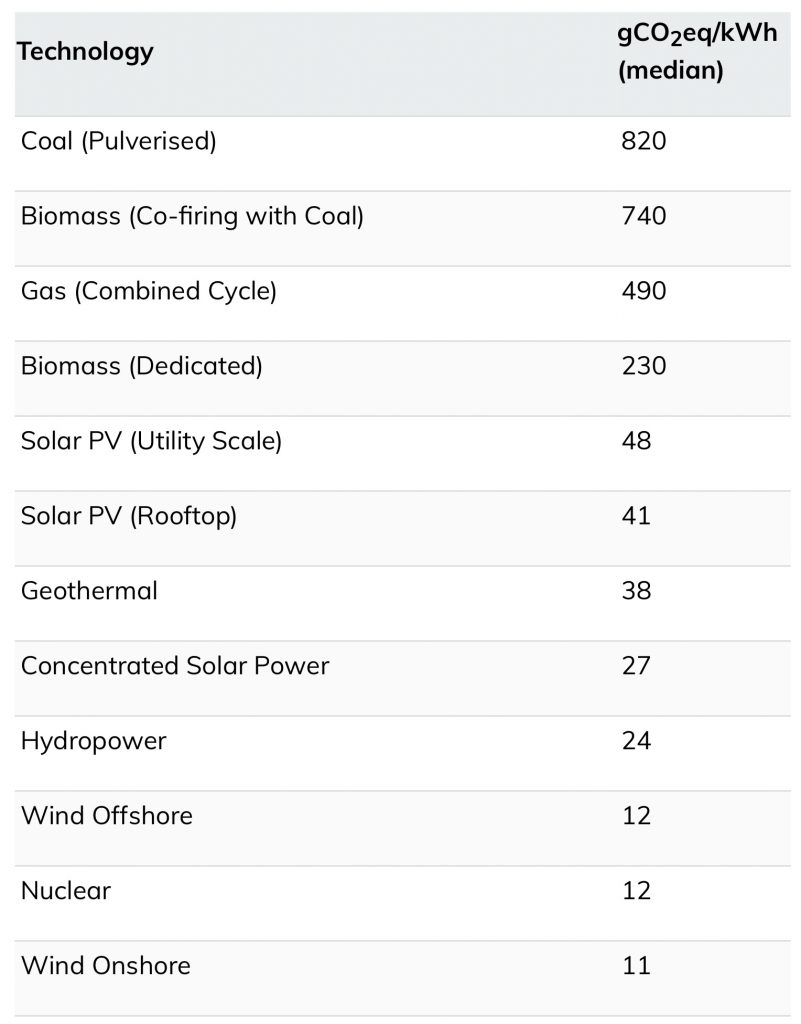CO2 production is increasingly of interest as the world struggles to limit man-made climate change. As we use different energy sources each represents a certainly amount of CO2 reflecting a combination of the energy invested to create that power source (e.g. the wind turbine may generate wholly renewable power, but its construction created some CO2) and the CO2 created as it generates energy once constructed (nothing for renewables but relatively high for fossil-fuelled generation).
I’ve previously shared this table showing the IPCC’s view of the embedded CO2 in different sources of electricity generation.

A recent question and resulting discussion in an on-line forum prompted me to think more about the area of embedded CO2.
My first observation would be that my rooftop solar panels do quite well on this scale with a CO2 figure of 41 gCO2/kWh.
The second observation would be regarding energy storage. My view would be that any energy storage device from a small scale domestic battery like my own to a large pump storage scheme can never deliver better embedded CO2 that the source of its energy. So, for example, if I charge my battery from my own solar at 41 gCO2/kWh with a cycle efficiency of 80% (the maker’s claim) then the embedded CO2 in the energy coming out of the battery cannot be better than 41 gCO2/kWh / 80% = 51 gCO2/kWh. Indeed it would be worse than that as this doesn’t account for the CO2 generated in creating the battery nor its operational life, but I don’t have figures for those.

Thirdly, as my own embedded CO2 is relatively low whether exported directly from my panels or indirectly via the storage battery, then the CO2 intensity of the grid always benefits from my export. The 116 gCO2/kWh illustrated above is pretty low for the UK grid which varies widely but is still more than my solar PV directly or stored solar PV. Indeed had I exported onto the grid at the time illustrated above then my 41 gCO2/kWh versus the grid’s 116 gCO2/kWh would have saved 75 gCO2 for each kWh that I exported.
However if, for example, I export electricity but need to then buy more gas to make hot water then that too has a CO2 impact.

If I need to buy a kWh of gas to make hot water that’s 0.2 kgCO2/kWh or 200 gCO2/kWh even before I’ve accounted for the relative inefficiency of the gas boiler versus my electric immersion heater. If I assume that the gas boiler is 90% efficient then I will be responsible for 200 gCO2/kWh / 90% = 222 gCO2/kWh for a kWh used to make hot water. Thus, while exporting 1 kWh of solar PV may save the electricity grid 75 gCO2/kWh, it’s added 222 gCO2/kWh to gas consumption – a net deterioration of 147 gCO2/kWh.
Natural gas of course is the lowest CO2 of the fossil fuels listed above – if your home is heated by oil, coal or wood then the analysis is further skewed towards using your own self-generated power rather than exporting electricity and importing another fuel for heating.
The electricity grid’s carbon intensity also varies. In 2019 the UK average was 256 gCO2/kWh (a little higher than my estimate for gas) however this varies considerably through the year with the highest embedded CO2 in early winter evenings when I have little if any solar PV to contribute to the grid, and may well be lowest when I and others have surplus solar PV. My understanding is that the lowest grid CO2 occurs with a combination of high renewables (such as particularly windy weather) coupled with low demand (such as summer nights).
Thus my own strategy is to:
- Maximise self-consumption of my own solar PV as my energy source with the lowest embedded CO2 (except in the event of an extreme plunge pricing event when the grid is under highest stress)
- Make best use of storage to minimise consumption from the grid in the evening peaks when embedded CO2 is likely to be highest.
- When a solar-shortfall is anticipated then buy electricity selectively from the grid at lowest CO2 (using Agile electricity price as a surrogate for CO2).
